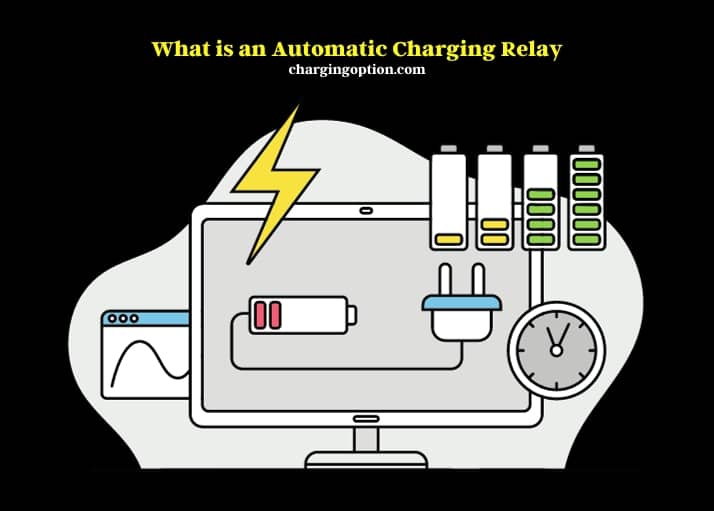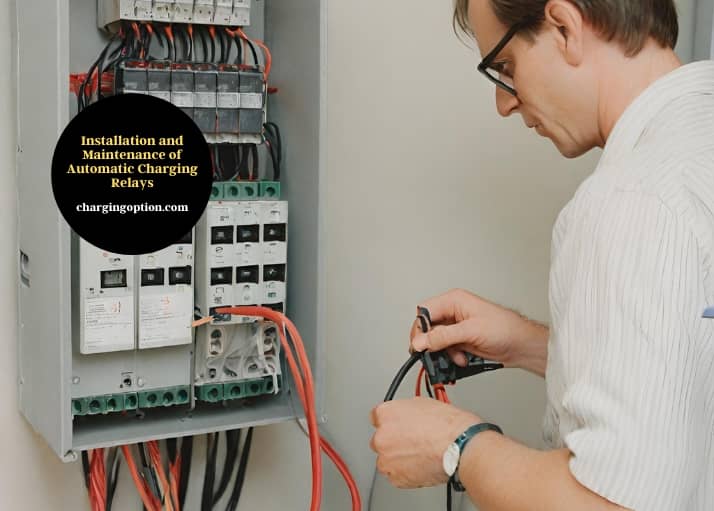An Automatic Charging Relay (ACR) is a device used in multi-battery systems to manage the charging process efficiently. It ensures that all batteries are charged without the risk of overcharging.
In the realm of electrical systems, particularly in marine and automotive applications, the ACR plays a pivotal role. It acts as a smart switch between the battery banks and the charging source, typically an alternator.
By monitoring the voltage levels, the ACR automatically connects the batteries to the charging source when the voltage reaches a certain threshold, indicating that the engine is running and the alternator is generating power. This feature is crucial for preventing the depletion of the primary battery used for starting the engine, thereby ensuring reliability and longevity of the system.

The ACR’s ability to isolate batteries when the engine is off and automatically reconnect them for charging when the engine is running makes it a superior choice over traditional diode-based isolators. This is because diode isolators often result in a voltage drop, which can lead to undercharging. The ACR, on the other hand, allows for more efficient charging by eliminating this voltage drop.
Its compatibility with various types of batteries, including lead-acid, AGM, and lithium-ion, makes it a versatile solution for diverse electrical setups. The simplicity of the ACR system not only enhances the overall battery life but also reduces maintenance needs, making it a valuable component in modern electrical systems.
Automatic Charging Relay Explained
An Automatic Charging Relay (ACR) serves as a critical component in modern electrical systems, particularly in vehicles and boats. Unlike traditional charging methods, which often require manual intervention, ACRs automate the process, ensuring efficient power management and battery longevity.
At its core, an ACR intelligently manages the charging of multiple batteries from a single source, like an alternator. It does this by monitoring the voltage levels and automatically connecting or disconnecting batteries based on their charge status. This functionality is crucial in preventing scenarios where a primary battery might be unintentionally drained, leaving essential systems like starting engines without power.
The role of ACRs in battery management systems cannot be overstated, as they not only streamline the charging process but also significantly reduce the risk of battery damage due to overcharging or deep discharging.
The Mechanics Behind Automatic Charging Relays
The operational mechanics of Automatic Charging Relays involves delving into their electrical principles and activation processes. Central to their function is the voltage threshold mechanism. An ACR activates when it detects that the charging source, typically an alternator, has reached a voltage high enough to indicate that the engine is running and the battery is charging. Once activated, the ACR connects multiple batteries to the charging source, ensuring each is charged appropriately.
Typical Voltage Settings and Responses in ACRs
| Voltage Level | ACR Response |
| 13.0 – 13.8V | Connect Batteries |
| Below 12.75V | Disconnect Batteries |
This table illustrates how ACRs respond to different voltage levels, ensuring optimal charging and protection for the batteries.
Advantages of Automatic Charging Relays in Systems
Incorporating Automatic Charging Relays into electrical systems brings numerous benefits. Primarily, they offer protection against overcharging, a common issue that can significantly shorten battery life. By intelligently managing the charging process, ACRs ensure that batteries are not subjected to excessive voltage, which can cause damage over time. This smart management extends the lifespan of batteries, proving cost-effective in the long run.
ACRs vs. Manual Charging Systems
| Feature | ACRs | Manual Systems |
| Overcharge Protection | Yes | No |
| Battery Lifespan | Extended | Standard |
| Efficiency | High | Variable |
This table compares the efficiency and protection offered by ACRs against traditional manual charging systems, highlighting the superiority of ACRs in power management.
Installation and Maintenance of Automatic Charging Relays
Installing and maintaining Automatic Charging Relays is a straightforward process, but it requires adherence to specific guidelines. The installation involves connecting the ACR to the charging source and the batteries it will manage. It’s crucial to follow the manufacturer’s instructions to ensure proper setup and functionality.
Regular maintenance of ACRs involves checking connections for corrosion, ensuring tight fittings, and periodically testing the relay’s operation to detect any potential issues. Troubleshooting common problems typically involves checking the electrical connections and ensuring the relay is receiving the correct voltage.

Future Trends in Automatic Charging Relay Technology
The future of Automatic Charging Relay technology is closely tied to advancements in the broader field of electrical systems and renewable energy. Emerging technologies are making ACRs smarter and more efficient, integrating them seamlessly with renewable energy sources like solar panels.
This integration paves the way for more sustainable and efficient power management systems. Predictions for future developments include enhanced smart charging capabilities, where ACRs can intelligently distribute power based on real-time demands and battery conditions, further optimizing energy use and prolonging battery life.
FAQs
How Do Automatic Charging Relays Function?
Automatic Charging Relays (ACRs) function as intelligent switches that connect and disconnect batteries from a charging source, like an alternator, based on the voltage levels. They monitor the voltage and automatically engage when the charging source reaches a sufficient level, ensuring that all connected batteries are charged.
This smart management prevents overcharging and undercharging, maintaining optimal battery health. ACRs are particularly useful in multi-battery systems, where they balance the charging without the need for manual intervention, thus simplifying the power management process.
Can Automatic Charging Relays Extend Battery Life?
Yes, Automatic Charging Relays can significantly extend battery life. By ensuring that batteries are neither overcharged nor undercharged, they maintain the batteries in their ideal state of charge.
Overcharging a battery can lead to excessive heat and damage, while undercharging can result in sulfation, both of which diminish battery life. ACRs intelligently distribute the charge among multiple batteries, ensuring each receives the right amount of power, thus prolonging their overall lifespan and performance.
Are Automatic Charging Relays Suitable for All Battery Types?
Automatic Charging Relays are versatile and can be used with various types of batteries, including lead-acid, AGM, gel, and lithium-ion. However, it’s essential to ensure that the ACR is compatible with the specific battery type and its charging requirements.
Some ACRs are designed with adjustable settings to accommodate different battery types and their unique charging profiles, making them a flexible solution for diverse power management needs.
What Makes Automatic Charging Relays Different from Isolators?
The primary difference between Automatic Charging Relays and isolators lies in their method of managing multiple batteries. Isolators divide the charging source and send a separate charge to each battery, which can lead to uneven charging if the batteries have different states of charge.
In contrast, ACRs allow batteries to be charged together when the voltage is high enough, ensuring a more balanced and efficient charge. This method is particularly beneficial in preventing the undercharging of secondary batteries, a common issue with isolators.
How Do Environmental Conditions Affect Automatic Charging Relays?
Environmental conditions, particularly extreme temperatures, can impact the performance of Automatic Charging Relays. High temperatures can increase the risk of overheating, while cold temperatures might affect the relay’s sensitivity to voltage changes.
Most ACRs are designed to withstand a range of environmental conditions, but it’s crucial to choose a relay that suits the specific environment where it will be used. Regular maintenance and checks can help ensure that the ACR continues to function effectively, regardless of the environmental conditions.
Is Special Wiring Required for Installing Automatic Charging Relays?
Installing Automatic Charging Relays typically requires specific wiring considerations to ensure safety and efficiency. The wiring must be capable of handling the current that the ACR will manage, and it’s essential to use the correct gauge and type of wire.
The installation should include appropriate fusing to protect against potential short circuits. It’s advisable to follow the manufacturer’s guidelines for wiring and installation to ensure optimal performance and safety of the ACR system.
Summary
Automatic Charging Relays represent a significant advancement in battery management and charging systems. From their basic function and operational mechanics to their installation, maintenance, and future potential, ACRs play a pivotal role in ensuring efficient and safe power management. As technology evolves, so too will the capabilities and applications of these vital components, making them an integral part of modern electrical systems.
